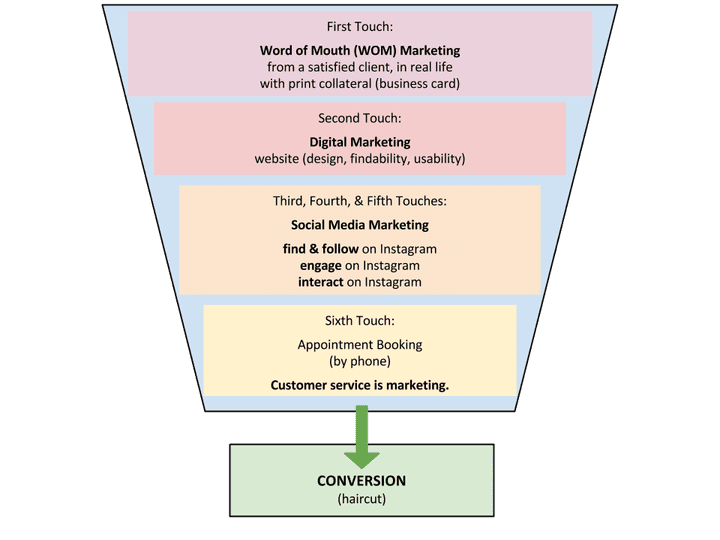Previously, we talked about how, and even if, you can calculate ROI for your small and medium business social media and content marketing efforts.
We discussed how it’s been a long time coming and that there are a lot of fine minds working on it. They’re developing best practices and tools for culling, tracking, and interpreting worthwhile social metrics. That is, the metrics that indicate whether or not you should keep (or start) bothering with social in the first place. Not just the so-called “vanity” metrics, such as whether or not they like you, they really like you.
Calculating ROI, Schmalculating ROI
In my last post, I equivocated. You can kinda, sorta figure out an ROI beyond a simple yes / no answer. You can get a good feel for whether it’s worth your time or not. But, most of us, as yet, can’t craft an airtight accounting methodology to do it. And, that is so frustrating.
What I want is a fractionated cost accounting system of interacting with each prospect and customer on each social platform. Then I’d want to compare that to the amount of money they trade me for my work. Then I’d play with percentages, tweak, optimize, run A/B tests, rinse, repeat, and so on.
There are enterprise-level applications that claim to have solved these problems, but only if you pay to play. I have yet to work with a client who has had deep enough pockets (and C-level buy-in) to fund these applications, plus available resources to manage the back-end work that goes into integrating them with existing technologies.
You need to be able to track a prospect through multiple touches with your organization, including in real life (IRL) and online, across various social networks, on the main areas of your site, on your blog, and even within the shopping cart, all the way to their first purchase. You then need to track returning customers across those same interactions to their next purchase.
For most of us, the personpower and talent necessary to achieve that kind of cross-API, site, and cart integration in order to follow a customer across Facebook Insights, Google Analytics, Magneto metrics, and cross-reference with Twitter interactions tra la la la la… The head swims.
Watch Out! Tracking the Wrong Metrics Can Be Worse than Tracking Nothing.
Stick with me here – Tracking the wrong metrics will distract you from content creation and community development. That’s where the money is. Well, not yet. But that’s where the money will be.
Grow the community around your products and services so that your conversations–and, ultimately, your conversions–have a place to happen.
You reap what you sow. Crops don’t grow in mid-air. They grow rooted in rich soil. Fecund even. As shepherds say, “You won’t increase the size of the lamb by weighing her.”
(Failing) To Figure ROI: An Integrated Salon Sales Funnel
I closed out our last post with a promise to share my not-enterprise-level ROI calculations. Certainly, it’s anecdotal and instructive nonetheless. I’ll leave that part as an exercise for you, dear reader, for how you draw parallels to your own business.
The Narrative of a Happy Customer
I’ve been planning to get my long hair cut short for about 18 months. I’ve been growing it out long enough to donate to a wig-making charity.
I was at a downtown coffee shop during a weekday morning rush hour last fall. A gal on her way to work breezed by me. She had a lovely short ‘do. (You notice these things when you’re looking for a new stylist; it’s nearly as delicate and important a search as for a soulmate. Am I wrong?)
The barista caught Sassy Short Hair’s attention and the gal stopped near where I was standing in line. I told her that I loved her haircut. She thanked me and almost kept on going. But, pivoting back to me, she said, “I’ve got a card here somewhere. I go to Urban Betty.” She told me her name and her stylist’s name. Dug a card out of her purse for me. She, too, knows about the Search for a Stylist.
For what it’s worth, I want you to know that Urban Betty will find out about this post when you do.
Life happened.
At some point after our coffee shop encounter, I browsed the salon’s site and thought it was adorable. I dig their pin-up girl branding and airy light in the salon. I started following them and the owner (Chelle Neff) on Instagram, and proceeded to flip through lots of photos.
Life kept happening.
As a crafter and distributor of content, it’s all too easy to forget that life keeps happening.
But as a consumer of content, you well know the prioritization head games we all play. Stolen moments, checkout lines and stoplights, in the bathroom, and “I’ll get to it when I get to it.”
Finally, I grew tired of having all that hair on my neck. So, I tagged the owner in the “most awkward selfie ever” with my hair measured against a ruler, asking if it’s long enough to donate. Are we theeeeere yet? I also asked for recommendations for a stylist.
https://instagram.com/p/4hrASIx4-N/
Needless to say, they got back to me, I got back to them, and now I am enjoying my newly shortened hair.
Translating My Client Testimonial into a Chronology of Touch Points
I’m calling this an “integrated” sales funnel because it includes visceral and virtual interactions, print collateral and digital marketing, word of mouth marketing and social media channels, and the exchange of cash money for services rendered. Huzzah!
Before we get too in-depth and start talking about fractional accounting methods (which won’t last long, believe me on that one), I need to add one more factoid to this tangled mess.
Urban Betty sends all donated hair to Pantene’s Beautiful Lengths’ program. As a surprise bonus, folks donating their braids get half-off. The price, that is. More than half off the hair. In my case anyway.
For our purposes, and so that my brain doesn’t explode, I’m going to set aside the following typical costs associated with launching an integrated marketing program. I’ve left a lot out because it was not applicable to this sale, e.g. search engine optimization and outbound marketing. After all, I was a direct site visitor.
- logo design
- graphic design and printing of business cards
- website design, development, hosting
- customer loyalty programs
- other retail marketing initiatives
Cost of a Lead
Namely me. I’d like to say that it’s zero cost, because it was all that lovely gal at the coffee shop last fall.
But, how do I know? Maybe they’ve put some dollars behind customer retention and loyalty programs.
In my experience, salons like this one have client-only appreciation events around the holidays or store anniversaries. Seems like some of those monies might be reflected here.
Or maybe the Sassy Short Hair gets a real dollar discount on her next service.
Cost of me as a lead = unknown, but probably not free.
Cost to Convert, or Customer Acquisition
I’m going to make up some numbers here for the sake of discussion.
Both the owner of the salon, or whomever runs her account, and the salon itself, or whomever runs that account, replied to me on Instagram.
Let’s say that each response took five minutes to type out with their thumbs. Let’s assume their time is accounted at Massage Therapist Standard, or $1 per minute. Two five-minute interactions comes to $10.
I would submit that these numbers are much higher than IRL. In real life, they’d be next to zero because nobody takes five minutes to type a response on Instagram. Unless they have an extenuating review process as in the case of big companies, tightly regulated industries, and nervous Nellies.
Cost of acquiring me as a customer = $10
But Wait! What about Upfront Costs? Ack!
As you know, it’s free to have an Instagram account.
That doesn’t mean that it’s free to “do” Instagram. I have no idea how much this business puts into their Instagram presence in terms of time, talent, and treasure. Do they pay to sponsor posts? Do they pay personnel to monitor the account and respond to all inquiries in a timely manner? Is it a methodical approach, scheduled on the daily calendar, for one employee or several? Or is it a catch-as-catch-can, round-robin affair?
To be thorough in our cost accounting, in order to calculate ROI with hard figures, we have to put all the costs of creating and growing an Instagram account into a bucket and divide it by all the new and returning clients who’ve been influenced by that account.
Have fun with that.
Customer Value
Hey, I didn’t tell you how much the haircut cost.
$53.
Divide by half because of the Charity Wig Discount.
$26.50
Less the cost of getting me in the door, $10.
My value as a first-time customer = $16.50.
Lifetime Customer Value
Am I going back? You better believe it!
Short hair requires more frequent cuts. I’ll probably get my hair cut 3 more times this year. At the regular rate. (Let’s not calculate my Lifetime anything. Who knows how long I’ll be in Austin or how long I’ll keep my hair short.)
3 times $53 plus the first cut = $185.50
For an initial investment of 2 replies on Instagram.
That’s a Pretty Gosh Darn Good Return, Isn’t It?
But, but, but. The fact that I plan to return as a client is related to a constellation of marketing decisions, not just the salon’s Instagram account.
But wait, there’s more!
Hey, come back.
I’m almost done.
My Stylist, Her Instagram, and Her ROI
I’m so glad I found my stylist, Chenoa. She was super great. She took photos before, after, and during our appointment, which is always fun and gratifying to the ego. Even better, she made a spiffy video (Flipagram) for me and shared it on her own Instagram account.
https://instagram.com/p/44MYSNMTqu/
Which I then shared to my Instagram account.
And Twitter.
And Facebook.
And, ya know, here.
As I’ve said before, social media marketing is fractal in its nature. Social shares are like ripples on a pond.
Let’s use the Massage Therapist Standard again. (I don’t know if that’s actually a thing, but it works for me to call it a $1 a minute and go from there.) Suppose it takes 15 minutes to put together a Flipagram, make sure it’s just so, post it to Instagram and add all those pesky tags. That would be a $15 investment for her.
If somebody asks her about the ROI on her social efforts, she doesn’t have to resort to that tired old canard I mentioned in the last post, “What’s the ROI on your mama?” Besides, Chenoa’s too nice to go there.
She can simply reply, “Gee, I don’t know. What’s the ROI on a fractal?” There you have it.
Feature image credit: Flickr user Waldo Jaquith, License: CC Attribution-Share-Alike
Latest posts by Suzanne Hoenig (see all)
- The Anti-Social-Media-Marketing Manifesto 2016 - October 19, 2016
- Which 3 Social Media Platforms Will Be Around in 3 Years? - October 13, 2016
- White Papers: Still a Way to Compel and Convert Leads - September 14, 2016






